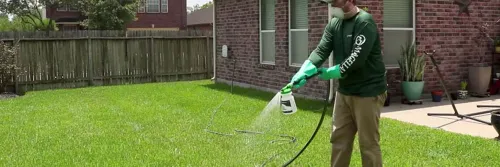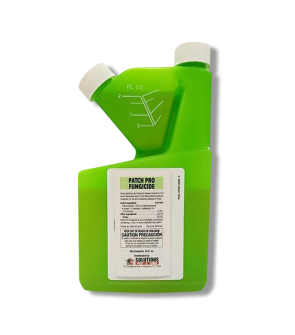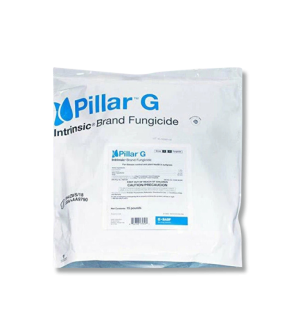Gain access to personalized product screening, the best pricing, rewards, and more!
Most Effective Products
Necrotic Ring Spot Control: How To Get Rid of Necrotic Ring Spot
This page is a general guide to controlling necrotic ring spots. By following this guide and using the recommended products, you will control the disease known as necrotic ring spot. We guarantee 100% control of necrotic ring spot.
Necrotic ring spot is a fungal disease that can kill turfgrass if there is no intervention. Caused by Leptosphaeria korrae, a fungus known to infect the roots of turf, necrotic ring spots infest lawns across the country, particularly during cool and wet weather.
Characterized by rings of dead grass, necrotic ring spot creeps up often in places that are not well-fertilized. There are various reasons that necrotic ring spots may appear on your lawn, but they usually occur through overwatering or poor mowing practices.
If left untreated, necrotic ring spot can begin to spread through spores and overtake a lawn. Common types of grass that can be severely affected by necrotic ring spot include Kentucky Bluegrass and Bentgrass, as well as Ryegrass, Red Fescue, and tall fescue.
If you have discovered necrotic ring spot on your lawn, it is crucial to move forward with a treatment program. Our DIY treatment guide below was compiled by lawn care specialists and, if you follow the steps carefully, will guarantee the removal of necrotic ring spot from your lawn.
Identification

Before you can proceed with treatment, you need to be certain that you are seeing necrotic ring spot on your lawn and not some other disease. Here are some facts and characteristics about necrotic diseases and what it looks like to help you with identification.
- Necrotic ring spot is often confused with another lawn disease, summer patch, so much so that they were once thought to be the same disease.
- The main factor that differentiates the two is the time of year at which the diseases start to develop. The necrotic ring spot tends to develop in late spring or fall, whereas the summer patch develops in the summer, as its name makes clear.
- When necrotic ring spots are present, they usually occur during cool and wet weather in the spring and fall seasons.
- The symptoms of the disease initially appear as small clustered patches of gray-tan colored turf between 6 to 8 inches in diameter.
- During conducive conditions, the patches develop an irregular donut shape with dead grass on the outside and a patch of healthy grass in the middle.
- Due to the necrotic ring spot being a root disease, initial above-ground symptoms start with discolored leaf tips followed by a collapse of the leaf and a decline of the entire turf.
- Infected roots are affected by stunted growth and look worn and dead compared to healthy roots.
Refer to the image above and our description to help you identify the necrotic ring spot. If you are still not totally sure, contact us, and we'll help you correctly identify your issue.
Inspection

After you have confirmed that you are dealing with necrotic ring spot, you can proceed with inspection. During this phase you will locate the areas where necrotic ring spot is prevalent and check for conditions that may be helping the disease to thrive.
Where to Inspect
Necrotic ring spot is known to infect popular lawn cool-season grasses such as Kentucky Bluegrass and Annual Bluegrass on golf courses, sports turf, professional landscapes, and residential lawns.
Playing fields and landscapes with a mixture of Annual Bluegrass and Creeping Bentgrass may suffer from a blotchy or scattering appearance as a result of necrotic ring spot taking hold. Necrotic ring spot is often seen as a disease of younger turfgrass, but disease development can also occur in older turf.
What To Look For
Look for scattered patches of discolored or dead grass in areas of your lawn that are particularly shaded or having poor drainage. When it is summertime, look for spots that dry out easily in the heat, as summer stress can exacerbate necrotic ring spots.
Treatment
Before handling any chemicals, we suggest wearing the proper safety equipment for the job to prevent chemicals from coming in contact with your eyes or skin. Gloves, safety goggles and long-sleeved clothing should suffice.
Our top recommendation for controlling necrotic ring spot is Patch Pro. This product contains the active ingredient propiconazole, which works systemically to treat common diseases like necrotic ring spot and keep them from spreading. Patch Pro is also cost-effective and one of our more affordable fungicides.
Step 1: Measure & Mix Patch Pro

Determine how much Patch Pro you need by measuring the square footage of the treatment area. To find the square footage, measure the treatment area's length and width in feet, then multiply them together (length X width = square footage).
The label says to use 4 fl. oz. per gallon of water per 1000 sq. ft. For example, if you measured a 2,000 sq. ft. area , this means you need 8 oz. to treat your yard mixed with 2 gallons of water. Mix the Patch Pro in a 20-gallon hose-end sprayer for large volume treatments.
We recommend mixing Patch Pro in a 20 gallon hose-end sprayer to make large volume treatments to a yard and to provide sufficient enough water for the Patch Pro to reach the root system of your turf.
Make sure the sprayers control valve and water pump are off and then attach the hose-end sprayer nozzle to the hose. Remove the reservoir and then add the proper amount of Patch Pro and the proper amount of water.
For large volume applications, use 2 or more gallons per 1,000 sq. ft. for the product to reach the roots. The product will mix with the water and create an even emulsion. Reattach the reservoir to the nozzle and turn the water to the hose on. You are now ready to spray.
Step 2: Apply Patch Pro To Affected Areas

To spray, push forward on the control valve of the hose-end sprayer.
Apply Patch Pro to infected areas spraying to wet but not to the point of runoff. The key is to focus on low lying areas of the yard that get a lot of shade as they are more susceptible to Summer Patch. You will also want to make sure to spray other vegetation around the infected area to prevent spores from spreading.
Apply liberally on the affected areas. The key is to act quickly and apply the fungicide where the necrotic ring spot has been observed. Sprays should be used when weather conditions favor pathogen activity in the soil, for example, when temperatures at the 3” depth range between 60 to 70 degrees Fahrenheit. These soil temperatures are usually seen in the spring and fall months when the weather is generally mild and wet. So it is essential to apply Patch Pro in spring or fall depending on your local conditions.
28 days later, a second application should be conducted. The disease that causes necrotic ring spot is soil-borne, so it is important that the Patch Pro applications make it down deep into the soil where the grassroots are. This can be helped with irrigating the lawn before or after application or aerating the lawn before application.
Prevention
If you don't want a necrotic ring spot to make a comeback on your lawn, you can do a few things to lessen the chances of re-infestation.
- Rake and dethatch your lawn in spring, reduce shade by trimming tree branches and aeration in the Spring and/or fall will encourage deep rooting, improving the chance of turfgrass survival and recovery.
- Relieve summer stress through a regular watering routine of 1 to 1.5 inches of water a week.
- Implementing a balanced nitrogen fertilizer program and raising mowing heights to 3” will reduce demands on the root system and help lessen the chances of turf decline during hot dry conditions.
Key Takeaways
What is Necrotic Ring Spot?
- Necrotic ring spot is a turf disease caused by fungal spores in the air. These spores can lie dormant for 30 years and suddenly become active and infect your lawn.
How to Get Rid of Necrotic Ring Spot
- Our top recommended fungicide to control necrotic ring spot is Patch Pro. It is highly effective against the disease and an affordable option.
Preventing Necrotic Ring Spot Reemergence
- Once your lawn has been treated, keep the necrotic ring spot away with a consistent lawn care and maintenance program, which includes aeration, fertilizer application, and regular watering and mowing.









